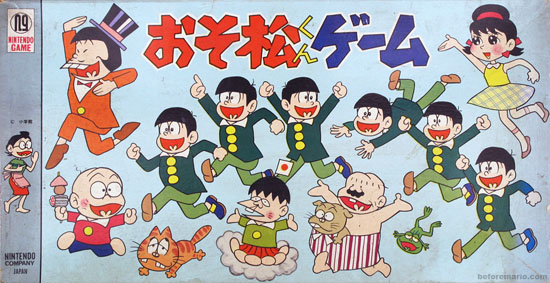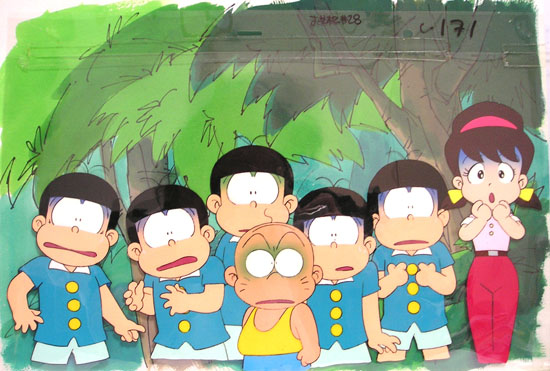
Cartoonist Fujio Akatsuka (1935-2008) is a household name in Japan. He pioneered in “gag manga”, Japanese comics that are based around jokes and humor. Fujio made comics with outrageous characters and ridiculous storylines, often satirizing the Japanese society. He was, in another words, a Japanese Milt Gross. He was published since 1956, but it wasn’t until the debut of Osomatsu-Kun that Akatsuka made it big.
Osomatsu Kun first appeared in 1962 on Weekly Shōnen Sunday. The cartoon was about the misadventures of 10-year old sextuplets: Osomatsu, Karamatsu, Choromatsu, Ichimatsu, Jūshimatsu, and Todomatsu. They are all identical, all wearing the same clothes, same hairstyle, and having the same basic mischief personality. Early storylines were all based around people getting mixed up with the six kids due to how they all look alike.
After a while, though, this premise can get thin (the comic ran until 1969), and Fujio Akatsuka probably felt the same because he started featuring two characters that would ultimately steal the show: Iyami, a buck-toothed conman who claims to be from France, although there is evidence that he never even went there. A recurring trait is that, whenever Iyami is surprised, he would hold a special pose and yell “Shee!” This would become a pop culture staple in Japan, and was parodied in other media; Godzilla even did that pose in one of his films. The other character is Chibita, a short, bald-headed kid who is the butt of the jokes from the sextuplets. He is almost always seen eating “oden”, a popular Japanese food. Many later stories involve around those two characters scheming up get-rich plans, usually by scamming the sextuplets. In fact, it’s safe to say that Iyami and Chibita became the true stars of the series, with Osomatsu and his brothers being side-characters, if they appeared at all.

There are other characters such as Dekopan, a overweight man who is always naked except for his large boxers, in which he carries several cats inside; Hatabō, a tiny boy modeled after Buster Keaton who has a small Japanese flag growing out of his scalp; and Dayōn, a man with an incredibly large mouth who always shows up in random places.
In fact, if there is one Japanese cartoon that has little-to-no episode-by-episode continuity, it’s this one. Just about all the characters have different roles in every episode. In one episode, Iyami is a doctor, then an inventor in another, and even a detective in the next. Chibita is the same thing; sometimes he’s a sidekick to Iyami, but in another he’s a victim of his scams. They could also be ninjas in another episode, or filmmakers. Same thing with Dekopan and Dayōn. Basically, whatever role is needed in a storyline, they can fill it in just to service the plot.
One of the more famous (and surprisingly emotional) storylines features Chibita being released from prison after he was sentenced for breaking into safes, being reunited with his sidekick Hatabō. Upon release, he vows to never crack safes again, even though Detective Iyami doesn’t believe him, saying that if he breaks open just one more safe, he will be sent back to prison. He gets a job at a fish store, trying to make a new living. However, he had to break his vows when Osomatsu gets locked inside a large safe while it was being delivered to his home. With no key in sight, Chibita reluctantly cracks it open in order to let them go. Iyami, touched, tells Chibita that he won’t arrest him for it. Nonetheless, the next morning, Chibita has left his job, having decided to move to a new life with his former partner Hatabō.
Two anime series were made based on the comic.
The first show, which was filmed in black and white, aired on MBS (Mainichi Broadcasting System) from February 5, 1966 to March 25, 1967, on Saturday nights at 7:30 pm. 56 episodes, each divided into two segments, were made. It was co-produced by Children’s Corner (which also worked on Joe Oriolo’s Johnny Cypher) and Studio Zero.
Studio Zero was formed by a group of Japanese cartoonists, which included Fujiko Fujio (Motō Abiko and Hiroshi Fujimoto), Shotaro Ishinomori, Jirō Tsunoda, and Fujio Akatsuka himself. Studio Zero produced poor animation, although that was the norm in mid-1960s Japanese television. The only important person with an actual animation experience was Shin’ichi Suzuki (b. 1933), who served as one of the writers and directors of the show. Fujio Akatsuka himself supervised the show. Often times the show took advantage of the fact that there are six characters that look exactly alike by reusing the same character animation six times in a single shot. For example, if the sextuplets are running past the screen, they would simply reuse the same run cycle six times in a row.
The show did well enough to last a year, and it served well as the first original animation for the MBS network. Unfortunately, the show was produced in black and white, meaning that it didn’t have much shelf life once Japanese TV started to embrace color. It was being rerun into the 1970s, but the show went missing after that. In 1990, they found 16mm broadcast prints of the entire run in a TV station warehouse. The entire series was later released on DVD box-sets.

A second show, this time in color, was produced by Studio Pierrot, airing Saturday evenings at 6:30 pm on Fuji Television from February 13, 1988 to December 30, 1989. 86 episodes were made. While the 1966 series did emphasize the sextuplets, even with prominent appearances of Iyami and Chibita, the 1988 series just cuts to the chase and puts the spotlight on the two, Iyami especially. The theme song for the 1980s show was about Iyami, with very minor appearances of Osomatsu and his brothers. It’s a wonder why the show wasn’t named after him at this point. 90% of the show’s episodes are seemingly based around the latter half of the comic’s run, when Iyami and Chibita defacto became the star of the series, with Osomatsu and his brothers being glorified side-characters.
The 1980s show was better produced than the 1960s one. While the animation can be really frantic at times, it still suited the comic’s wacky tone better than the stilted black and white series. For this version, they opted to utilize the entire half-hour time-slot rather than dividing the episode into two segments, which I think was a good idea, giving room for more gags and situations, as well as providing some breathing room for the otherwise frantic and fast-paced humor in the show.
Nowadays, Osomatsu-Kun is overshadowed by Fujio Akatsuka’s other properties, such as Tensai Bakabon and Akko’s Secret, but the characters are still well-remembered and it’s still associated with the creator’s overall work. Hard to believe that a cartoon featuring identical sextuplets got overshadowed by a strange, buck-toothed man and a bald, short kid.


 Charles Brubaker is a cartoonist originally from Japan. In addition to his work for MAD Magazine and SpongeBob Comics, he also created Ask a Cat for GoComics. You can also follow him on his Tumblr page.
Charles Brubaker is a cartoonist originally from Japan. In addition to his work for MAD Magazine and SpongeBob Comics, he also created Ask a Cat for GoComics. You can also follow him on his Tumblr page.











































It’s funny how the background characters can end up becoming the more interesting than the leads in certain series and films. An American example: Scat the Squirrel from the Ice Age franchise.
Or Popeye.
there’s always Snuffy Smith taking over for Barney Google!
Also the Smurfs were actually a spin-off from an earlier comic strip by Peyo, “Johan and Peewit” (Johan et Pirlouit).
Osomatsu-kun also found it’s way to the Sega Mega Drive (a.k.a. Genesis) as one of it’s earliest titles released in the late 80’s…
http://www.youtube.com/watch?v=5yKWEi5tBe4
Intresting that you mention that because the board game that is shown on top of the page was produced by Nintendo, long before they got into video games.
There were a lot of things Nintendo did before video games in the 20th Century, ranging from playing cards to board games and even a Lego knock-off. You can find out more at this blog I recommend checking out!
http://blog.beforemario.com/
Thanks for all the great info I hadn’t known about the series. I can’t believe I hadn’t drawn the connection with Godzilla until now.
The story behind that was that actor Yoshio Tsuchiya, who played the Controller of Planet X in that film (MONSTER ZERO – Toho; 1965), was a big fan of Fujio Akatsuka’s comic strips, and asked SPFX director Eiji Tsuburaya to have Godzilla do a “shee” pose in honor of the strip. Since Eiji had been wanting to make Godzilla more child-friendly and somewhat playful (the previous film, GHIDORAH THE THREE-HEADED MONSTER, was the first film in which Godzilla became the good guy, albeit a reluctant anti-hero), he was happy to include this scene! Principal director Ishirou Honda, however, was not impressed, and for a while, put off from working on Godzilla films (he preferred Godzilla being the villain, like the famous 1954 original). However, Honda and Tsuburaya continued to work together on other tokusatsu (Japanese SPFX) films at Toho, including their last Godzilla film together, DESTROY ALL MONSTERS (Toho; 1968), until Tsuburaya’s passing in early 1970.
It was nice to stick such a silly thing like that in there and not think to how those outside Japan wouldn’t get the reference anyway.
I read how Fujio Akatsuka most famous works feature side characters who become more famous than the original stars.
It’s not the first time it happened with cartoonists, it’s just odd that it happens with this one cartoonist so often.
Yeah. To name other examples, “Moretsu Ataro” was named after an orphaned child running the family vegetable shop, but a cat named Nyarome ultimately took over. “Tensai Bakabon” was named for the son Bakabon, but his father later became the star (although Bakabon was still prominent as a second banana to his insane father).
“Akko’s Secret” is probably the only exception. Akko-chan was still the star throughout the run.
I think I may have to borrow that thought in creating one of my cartoons!
I just came across an entire episode of the 1988 series that’s a send up to film The Great Race. Wacky Races was pretty popular in Japan so it’s been referenced in various shows but Pierrot went straight to the source material and based it in that time period and setting. Iyami and Chibita even fill in the roles of Dr. Fate and his henchman Max.
Oops, I meant to type Professor Fate.
Well at least Pierrot decided to go one step further than the rest in that regard. Wacky Races was quite a big influence in Japan of these type of races in anime I noticed.